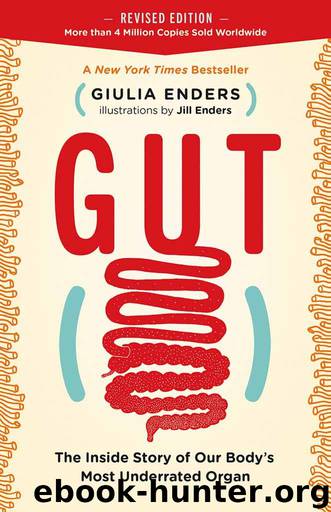Gut: The Inside Story of Our Body's Most Underrated Organ (Revised Edition) by Enders Giulia

Author:Enders, Giulia [Enders, Giulia]
Language: eng
Format: azw3, epub
Publisher: Greystone Books
Published: 2018-02-16T16:00:00+00:00
The Adult Gut Population
IN TERMS OF our microbiota, we reach adulthood around the age of three. For a gut, being an adult means knowing how you work and what you like. When that stage has been reached, some gut microbes find themselves on a great expedition with us through our entire lives. We dictate the itinerary—by eating what we eat, reacting to stress, going through puberty, getting ill, and growing old.
Those people who post pictures of their dinner on Facebook, only to be disappointed by the lack of “likes” from friends, are simply trying to appeal to the wrong audience. If there were such a thing as Facebug (Facebook for microbes!), a picture of your dinner would provoke an excited response from millions of users—and shudders of disgust from millions more. The menu changes daily: useful milk digesters contained in a cheese sandwich, armies of Salmonella bacteria hiding in a delicious dish of tiramisu. Sometimes we alter our gut flora, and sometimes it alters us. We are our flora’s weather and its seasons. Our flora can take care of us, or it can poison us.
We are only now beginning to learn the impact the gut-based bacterial community can have on an adult human. In this respect, scientists know more about bees than about human beings. For bees, having more diverse gut bacteria has been a more successful evolutionary strategy. They were only able to evolve from their carnivorous wasp ancestors because they picked up new kinds of gut microbes that were able to extract energy from plant pollen. That allowed bees to become vegetarians. Beneficial bacteria provide bees with an insurance policy in times of food scarcity: they have no trouble digesting unfamiliar nectar from far-flung fields. More specialized digesters are not so well equipped. Times of crisis highlight the advantage of hosting a good microbial army. Bees with well-equipped gut flora can deal with parasite attacks better than those without. Gut bacteria are an incredibly important factor in this evolutionary survival strategy.
Unfortunately, we cannot simply transfer these results to humans. Humans are not bees; they are vertebrates and they use Facebook. So researchers have to go back to square one. Scientists investigating our gut bacteria have to learn to understand an almost completely unknown world and its interaction with the world outside. First, they need to know who is living inside our gut.
So let’s take a closer look. Who exactly are these characters?
Biologists love to put things in order—from the contents of their own desks to the entire contents of the world. They begin by sorting everything into two large drawers: one for living things and the other for non-living things. They then go on to divide everything in the first drawer into three categories: eukaryotes, Archaea, and bacteria. Representatives of all three groups can be found in the gut. I am not promising too much when I say each of the three groups has its own kind of charm.
Eukaryotes are made up of the largest and most complex cells.
Download
Gut: The Inside Story of Our Body's Most Underrated Organ (Revised Edition) by Enders Giulia.epub
This site does not store any files on its server. We only index and link to content provided by other sites. Please contact the content providers to delete copyright contents if any and email us, we'll remove relevant links or contents immediately.
| Administration & Medicine Economics | Allied Health Professions |
| Basic Sciences | Dentistry |
| History | Medical Informatics |
| Medicine | Nursing |
| Pharmacology | Psychology |
| Research | Veterinary Medicine |
Periodization Training for Sports by Tudor Bompa(8170)
Why We Sleep: Unlocking the Power of Sleep and Dreams by Matthew Walker(6618)
Paper Towns by Green John(5089)
The Immortal Life of Henrietta Lacks by Rebecca Skloot(4525)
The Sports Rules Book by Human Kinetics(4294)
Dynamic Alignment Through Imagery by Eric Franklin(4116)
ACSM's Complete Guide to Fitness & Health by ACSM(3989)
Kaplan MCAT Organic Chemistry Review: Created for MCAT 2015 (Kaplan Test Prep) by Kaplan(3939)
Introduction to Kinesiology by Shirl J. Hoffman(3725)
Livewired by David Eagleman(3683)
The Death of the Heart by Elizabeth Bowen(3551)
The River of Consciousness by Oliver Sacks(3540)
Alchemy and Alchemists by C. J. S. Thompson(3449)
Bad Pharma by Ben Goldacre(3355)
Descartes' Error by Antonio Damasio(3230)
The Emperor of All Maladies: A Biography of Cancer by Siddhartha Mukherjee(3064)
The Gene: An Intimate History by Siddhartha Mukherjee(3047)
The Fate of Rome: Climate, Disease, and the End of an Empire (The Princeton History of the Ancient World) by Kyle Harper(3003)
Kaplan MCAT Behavioral Sciences Review: Created for MCAT 2015 (Kaplan Test Prep) by Kaplan(2936)
